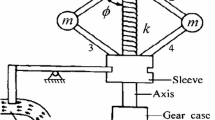Abstract
A single-axis flux decay model including an excitation control model proposed in [12,14,16] is studied. As the bifurcation parameter P m (input power to the generator) varies, the system exhibits dynamics emerging from static and dynamic bifurcations which link with system collapse. We show that the equilibrium point of the system undergoes three bifurcations: one saddle-node bifurcation and two Hopf bifurcations. The state variables dominating system collapse are different for different critical points, and the excitative control may play an important role in delaying system from collapsing. Simulations are presented to illustrate the dynamical behavior associated with the power system stability and collapse. Moreover, by computing the local quadratic approximation of the 5-dimensional stable manifold at an order 5 saddle point, an analytical expression for the approximate stability boundary is worked out.
Similar content being viewed by others
References
Abed, E.H., Varaiya, P.P. Nonlinear oscillations in power systems. Int. J. Electric Power and Energy System, 6: 37–43 (1984)
Ajjarapu, V., Lee, B. Bifurcation theory and its application to nonlinear dynamical phenomena in an electrical power system. Transactions on power systems, 7(1): 424–431 (1992)
Bhaskar, R., Crow, M.L., Ludwig, E., Kelvin, T.E., Kirit, S.S. Nonlinear parameter estimation of excitation systems. IEEE Transactions on Power Systems, 15(4): 1225–1231 (2000)
Chen, G., Maola, J.L., Wang, H.D. Bifurcation control: theories, methods, and applications. International Journal of Bifurcation and Chaos, 10(3): 511–548 (2000)
Chen, R.L., Pravinp, V. Degenerate Hopf bifurcation in power systems. IEEE Trans. Circ. Syst., 35(7): 818–824 (1988)
Chiang, H.D., Wu, F.F., Prarin, V. Foundations of the potential energy boundary surface method for power system transient stability analysis. IEEE Trans. Circ. Syst, 35(6): 712–728 (1988)
Dobson, I., Chiang, H.D. Towards a theory of voltage collapse in electric power system. Systems and Control Letters, 13: 253–262 (1989)
Doedel, E.J., Fairgrieve, F.T., Wang, X. AUTO97 continuation and bifurcation software for ordinary differential equation, 1997
Guckenheimer, J., Holmes, P. Nonlinear oscillations, dynamical systems and bifurcations of vector fields. Springer-Verlag, New York, 1986
Jing, Z.J., Jia, Z.Y., Gao, Y.H. Research of the stability region in a power system. IEEE Trans. Circ. Syst., Part I , 50: 298–304 (2003)
Kwatny, H.G., Pasrija, Bahar, L.Y. Static bifurcation in electric power networks: Loss of steady-state stability and voltage collapse. IEEE Trans. Circ. Syst, 33: 981–991 (1986)
Padigar, K.R. Power system dynamics-stability and contral, John Wiley, Singapore, 1996
Parker, T.S., Chua, L.O. Practical numerical algorithms for chaotic systems. New York, Springer-Verlag, 1989
Peter, W.S., Pai, M.A. Power system dynamics and stability. Printice Hall, Upper Saddle River, New Jersey 07458, 2000
Qi, R., Cook, D., Kliemann, W., Vittal, V. Visualization of stable manifolds and multidimensional surfaces in the analysis of power system dynamics. J. of Nonlinear Science, 10: 175–195 (2000)
Rajagopalan, C., Lesieutre, B., Sauer, P.W., Pai, M.A. Dynamic aspects of voltage/power characteristics. Transactions on power systems, 7(3): 990–996 (1992)
Rajesh, K.G., Padiyar, K.R. Bifurcation analysis of a three node power system with detailed models. Electrical Power and Energy Systems, 21: 375–393 (1999)
Shen, J.Q., Jing, Z.J. A new detecting method for conditions of existence of Hopf bifurcation. Acta Mathematicae Applicatae Sinica, 11(1): 79–93 (1995)
Tan, C.W., Varghese, M., Varaiya, P., Wu, F.F. Bifurcation, chaos, and voltage collapse in power system. Proceedings of the IEEE, 83(11): 1484–1496 (1995)
Venkatasubramanian, V., Ji, W.J. Numerical approximation of (n − 1)-dimensional stable manifolds in large systems such as the power system. Automatic, 33(10): 1877–1883 (1997)
Zaborszky, J., Huang, G., Zheng, B. A counter-example on a theorem by Tsolas et al. IEEE Tran. Automat. Control, 33(3): 316–318 (1988)
Author information
Authors and Affiliations
Corresponding author
Additional information
Supported by the National Key Basic Research Fund (No.G1998020307) and KZCX-2-SW-118 Chinese Academy of Sciences.
Rights and permissions
About this article
Cite this article
Gao, Yh. Bifurcations and Stability Boundary of a Power System. Acta Mathematicae Applicatae Sinica, English Series 20, 513–532 (2004). https://doi.org/10.1007/s10255-004-0189-4
Received:
Revised:
Issue Date:
DOI: https://doi.org/10.1007/s10255-004-0189-4




